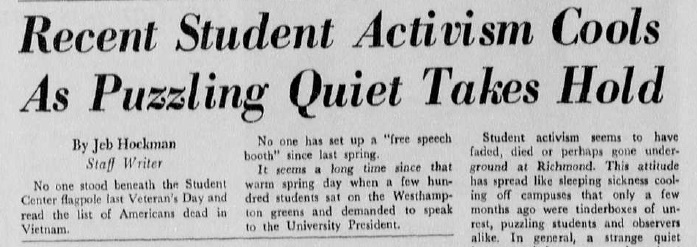by Sabrina Garcia
Sabrina Garcia is a junior from, Waldwick, New Jersey double majoring in Leadership Studies and English and minoring in Women, Gender, and Sexuality Studies (WGSS). This is her first year working on the Race & Racism Project, on Team Archive. Sabrina is in the WILL* Program, works as a writing consultant, and is training to be a PSMA. She hopes to dedicate her career to social justice and believes in the mission of Race & Racism wholeheartedly.
 On February 5, 1971, an article was published in The University of Richmond Collegian, titled “Recent Student Activism Cools as Puzzling Quiet Takes Hold.” This piece focuses on the ways in which Richmond students lost their drive and ambition to be persistent in their activism, as opposed to the flare of student activism that was seen the previous year in the wake of the Cambodian Crisis and the Kent State Shootings. There was student unrest throughout the United States during the year 1970, due to the involvement in the Vietnam War, and the Cambodian Crisis. This all led up to the violence seen at Kent State, as four students were killed during student protests by the Ohio State Guard. Students at the University of Richmond reacted to the national outrage, by organizing protests and rallies of their own, and voiced their dissent from President Nixon’s decision to continue bombing Cambodia.
On February 5, 1971, an article was published in The University of Richmond Collegian, titled “Recent Student Activism Cools as Puzzling Quiet Takes Hold.” This piece focuses on the ways in which Richmond students lost their drive and ambition to be persistent in their activism, as opposed to the flare of student activism that was seen the previous year in the wake of the Cambodian Crisis and the Kent State Shootings. There was student unrest throughout the United States during the year 1970, due to the involvement in the Vietnam War, and the Cambodian Crisis. This all led up to the violence seen at Kent State, as four students were killed during student protests by the Ohio State Guard. Students at the University of Richmond reacted to the national outrage, by organizing protests and rallies of their own, and voiced their dissent from President Nixon’s decision to continue bombing Cambodia.
Despite this rise in student activism, the likes of which had never been seen before on the University of Richmond campus, the article describes the silence of the following year. Jim Winders, a Richmond College senior at the time, and leading figure in the activist movements, said that the demonstrations on campus in 1970 were “unique—at least unique for this campus.” He explained that many students felt disheartened upon realizing that real change takes time, and lost the zeal that led them to organize. Sophomore Gaston Williams thought that students lacked an event to rally around, and “not a whole lot of people give much of a damn about anything this year.” The article ends with an uncertain tone, not knowing if campus activism is really dead, or just waiting to burst to the surface.
This article reflects a greater issue that the University of Richmond faces: it has never been a space where student activism is welcomed. This campus has not seen mass student activism compared to other liberal arts colleges. The question I have come to ask is: “Is this campus creating space for student activism?” The answer to that question: No, it is not. Much of this has to do with the demographic of this campus, being a predominantly white institution, how well supported minority students are on this campus, and how well they are able to interact with each other. Although racial climate and policy decisions are two different things, white students found it easier to mobilize around such a violent event such as Kent State, than to see the systemic racism in the school that does not affect them on a daily basis.
Upon coming to the University of Richmond, I quickly learned how each marginalized group tends to stick to their own; and how there is no space on campus for students of color and marginalized students to gather and share their experiences. This may not be the intention of the administration, but marginalized students should not have to rely on each other to create a welcoming space at their place of learning. Especially at a university that claims to be “diverse” and an “accepting” place. The University of Richmond is a space where it is difficult for marginalized students to gather and practice activism, because they are unable to find each other in the crowd. Social life as well is predominantly a white space, and with such an overwhelming feeling of “otherness” in many facets of life, students of color do not feel as though they are reflected in spaces on campus. It is my belief that words do not have the same effect as action. This is the very creed that activist work relies on; words allow support, they inspire change, but action is needed to see those words become truth. This University may claim to be a “diverse, inclusive” space, yet when I look around all I see is white.
